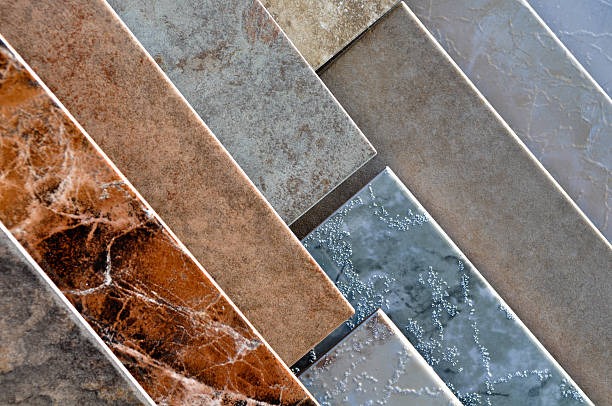Rectified tiles have edges that are smooth as well as precise and consistent. They make for an easy installation and create a contemporary sophisticated and elegant look.
Non-rectified tiles (also known as pressed) retain their natural soft and organic edges which are perfect for traditional or rustic tile designs. They do, however, require more grouting to cover up the differences between tiles.
Grout Joint Width
The aesthetics of your tile installation will be affected by the tile is rectified (or not) because the size of the grout line will vary on the type of tile.
Rectified tiles have been mechanically cut and ground to reduce sizing variations on their edges, and give them an even appearance and smoother finish. They can be put up with smaller grout joints up to 1.3mm.
Non-rectified tiles have not been treated this way and can show size differences from one tile to the next particularly if they’re constructed with clay-based materials like ceramic or porcelain. These imperfections can give a rustic, organic feel to any room. They’re also employed for projects that have vintage, earthy or natural design.
Before starting the project the client must have a rough idea of the final grout line. This will assist them find a grout width that will meet their needs and provides a professional-quality result while minimizing the likelihood of costly callbacks later down the road. This will assist them in finding a grout width that meets the requirements of their project and gives a professional-quality result while minimizing the possibility of costly callbacks in the future.
Ask your wholesale tile provider about the appropriate grout joint sizes for specific types of installations. Certain substrates, like need a wider grout joint to prevent cracking and displacement.
Non-rectified tile grout dimension
For both porcelain and ceramic tiles, kilning, or exposure to intense heat is the last stage during their manufacturing. The process causes a small shrinkage of the gach trang tri 30×60 edges of both porcelain and ceramic tiles. This is referred to as cupping or crowning. It can result in a difference of 1-5 mm between tiles. Rectification is a process that reduces these tiny size differences between tiles. Once the tile is fired, the edges are cut using sawing or laser cutting. This process eliminates any irregularities on the edges of the tile and ensures that the edges are sharp and square.
The main reason people choose rectified tiles is because of its modern and sleek appearance. This kind of tile has an extremely tight grout line that creates a seamless and clean look.
This precise finish can be a challenge for installers, especially when installing larger sized tiles in small space. The use of spacers or leveling systems, and adhering to the the manufacturer’s guidelines are crucial.
Furthermore, it is important to select the correct grout. A grout that is not sanded is best for rectified tiles since it won’t be as abrasive on the tile, and it can assist in covering any irregularities within the edges of the tiles. It is a good idea for any tile work to prevent mildew and mold from developing.
Rectified tile vs. non-rectified tile difference
The most effective option if you want to create a sleek, seamless design is rectified tiles. The tiles are cut precisely at the time of manufacture, resulting in straight edges and uniform dimensions. This lets them be positioned closely together, which reduces the space and grout lines between the tiles.
Non-rectified tile, on the other hand, have the most natural edges, and size variations that lend traditional or rustic appeal to the spaces. These tiles are made of diverse materials, including porcelain, and can connect to historical designs. They are favored because they create a cozy warmth and a warm environment.
When it comes to choosing the style of tile you want to use for your home, the choice between rectified and non-rectified tiles is crucial and will impact your overall results. Selecting the appropriate tile to suit your needs will ensure that the finished outcomes are exactly as you envisioned.
Rectified tile is a type of tile that has been reprocessed by firing in order to get exact dimensions. This process is done by cutting, grinding or machining the edges of the tiles in order to give an even and smooth edge. The corners of rectified tile are generally at 90 degrees and have the added benefit of a bevel that is fine to ensure their safety.
Rectified tile aesthetics
Each detail is crucial when it comes to achieving the ideal tile installation. Rectified tiles are precise in manufacturing, which creates smooth and uniform edges to create seamless appearance. They’re particularly useful for larger sizes like our Helios or Venato porcelain tiles.
This can make the grout lines appear thinner and more streamlined, which is an aspect that many clients enjoy. This style can also make smaller spaces appear bigger because the tiles appear to disappear into the walls.
The natural edges of non-rectified tiles could be used to create natural, earthy designs. Furthermore, because of the variations in size that occur during firing non-rectified tiles require larger grout joints in order to achieve a seamless appearance.
While rectified tile offers an elegant and uniform appearance, it can be harder to set up than non-rectified tiles. In order to achieve a seamless appearanceit’s possible to employ precision tools as well as a skilled installer. It’s also a good idea to use a grout color that matches the tile’s hue because a grout that is not matched could draw attention and appear like it’s not finished. We suggest only professional installers install rectified tiles. We recommend ordering samples of this tile to compare the colors and finishes.



